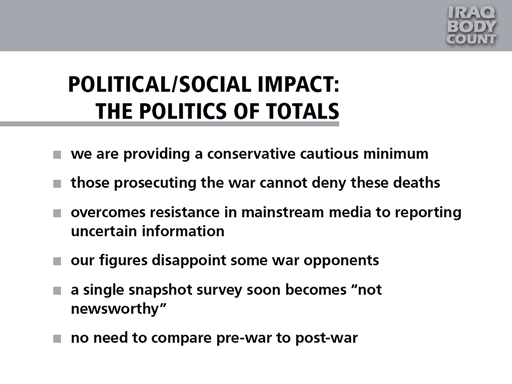In early 2006 IBC was invited to introduce its work at a Working Group Meeting on methods used by researchers to estimate armed conflict deaths (organised by the Small Arms Survey, Geneva, 17 Feb 2006).
Well-received by experts at the meeting, On Iraq Body Count summarised the project’s key features and innovations.
Political/social impact: the politics of totals
- we are providing a conservative cautious minimum
- those prosecuting the war cannot deny these deaths
- overcomes resistance in the mainsream media to reporting uncertain information
- our figures disappoint some war opponents
- a single snaphot survey soon becomes ‘not newsworthy’
- no need to compare pre-war to post-war
5.2 Political/social impact: the politics of totals
-
We are providing a conservative cautious minimum. The deaths recorded in our database are as certain and unassailable as it is possible to be. This means that those prosecuting the war cannot deny these deaths. They are forced to admit them.
-
This “unassailable nature” of our data overcomes resistance in mainstream media to reporting uncertain information. People are reluctant to print material which they cannot absolutely confirm. Even mainstream US media can (and do) print our data, and did so long before any comparable survey-based estimate became available.
-
The corollary of this is that our figures disappoint some war opponents who would like to propose that a higher figure has been established to an even greater standard of certainty.
-
A single snapshot (as in a survey) appears to “settle the matter” and can close minds. Once reported, it becomes no longer newsworthy or the subject of serious inquiry.
-
Deaths in our database are by definition war-related. There is no need for pre- and post-war comparisons or the morally dubious balancing of lives ended against lives saved. We do not use human lives as “exchange commodities” wherein military intervention can be justified if more lives are theoretically or demonstrably saved than would have been lost without such military action.
